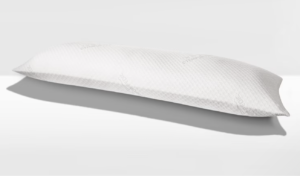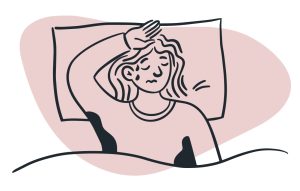7 Tips for Sleeping with Sciatic Pain During Pregnancy
Disclosure: By clicking on the product links in this article, Mattress Nerd may receive a commission fee at no cost to you, the reader. Read full disclosure statement.
Getting enough quality sleep is essential during pregnancy, but that may be difficult to do. Pregnancy may negatively impact your ability to rest by leading to sleep disruptions like back pain, indigestion, and an increased need to urinate at night.
It can also increase your risk of developing sciatica, a condition that causes nerve pain. Here’s why pregnancy and sciatica are related and how to improve your sleep if you experience it.
What is Sciatica?
The sciatic nerve is located in your lower back and pelvis. It helps control the muscles in your legs and feet. Sciatica occurs when this nerve becomes inflamed and irritated. It can last for weeks or come and go.
Sciatic Causes
The causes of sciatica include:
- Herniated or bulging disc
- Spine misalignment and spondylolisthesis
- Muscle spasms
- Pressure on the nerve from a mass or swelling
- Pressure from a growing uterus in pregnancy
Sometimes, though, there’s no apparent cause for sciatica at all.
Sciatica Symptoms
A person living with sciatica typically experiences lower back pain on one side. Other symptoms might include:
- Pain in the hip and leg
- Leg “heaviness”
- Leg weakness
Back pain is experienced by as much as an estimated 76 percent of pregnant people. Sciatica is a possible cause. You may see the signs of it in early pregnancy. But as the baby grows, the pressure might increase on the nerve leading to greater discomfort.
7 Tips for Sleeping with Sciatic Pain During Pregnancy
Trying to sleep with sciatica can be challenging and frustrating. Here are seven tips to try to improve your snoozing.
- Invest in a quality mattress
You might be surprised what a good quality mattress can do for your sleep. Your bed isn’t causing the sciatica pain, but it could be worsening it. A too-soft mattress may strain your spine due to a lack of support. But a firmer bed with the right balance of softness and firmness might help alleviate stress on the nerve.
The level of firmness depends on your preferred sleep position. Many mattress companies offer trial periods, so try a couple to see what’s best for you. This benefit might be even more helpful if you sleep in more than one position at night.
- Add pillows
It’s best to keep your spine as properly aligned as possible when sleeping. A great way to do this is by adding different pillows. So, try placing a pillow between your knees when lying on your side. Or place a pillow under them when on your back. This addition allows your back and hips to rest more naturally.
A maternity or body pillow is also something to consider. There isn’t much research into whether they can ease back pain, but many people say they felt an improvement.
- Exercise
Research suggests a combination of strengthening and stretching exercises two to three times per week may prevent lower back pain. Also, aerobic exercise might improve one’s sleep quality even without sciatica.
When you exercise, you increase your core strength, reduce inflammation and pressure on the nerve, and encourage tissue healing.
- Sciatica stretches
Here are some basic stretches for sciatica that you can do right before bed.
- Pigeon pose. With hands and knees on the floor, slide your right knee forward between your hands and your left leg back with your foot facing up on the floor.
- Bound angle pose. Sit on a blanket with your legs straight out in front of you. Your hips or groin should feel tight but not painful. Then, bend your knees, pull your heels toward the pelvis, and drop your knees to the side, pressing the soles of your feet together.
- Child’s pose. Sit on your knees with your knees spread apart and your big toes touching. Then, stretch out both arms as far as possible, touching the floor until you feel a nice stretch. Your tummy should rest between your thighs comfortably.
- Modified warrior pose. Kneel on the floor on your hands and knees. Then, carefully step one foot forward and bring your hip and knee to a 90-degree angle. Finally, shift your weight to the front until you feel a stretch in your back, hips, and leg.
A foam roller and prenatal massage may also help ease your pain.
- Follow a nighttime routine
A big part of sleep hygiene is following a nightly routine to help promote rest. Humans are creatures of habit, so your body responds to your schedule. Taking the same steps each night regulates your circadian rhythm allowing you to fall asleep faster.
Try taking a hot bath every night an hour or so before bed. Then, put on comfortable pajamas and read a book night after night. In time, your body will recognize that it’s bedtime when going through the motions. You also help create a calm and peaceful sleep environment.
- Hot or cold packs
Applying a heating pad or cold pack to the area where you’re experiencing pain before bed may help. When choosing between the two, find the one most comfortable for you. Both hot and cold temps can help in their own ways.
You will want to avoid sleeping on a heating pad or ice pack because they might damage your skin. Instead, try rotating the heat or ice to your back 20 minutes on and then 20 minutes off a couple of hours before bedtime while watching television or reading a book.
- Change your sleep position
Pregnancy comes with many changes to your body. So, it’s normal for your usual way to sleep to no longer be comfortable. For example, switch it up if you usually sleep on your back. Sleeping on your left side is considered one of the best sleeping positions for pregnancy.
Certain positions may require using additional pillows for support. The key is to keep your neck, back, and hips aligned no matter how you sleep. You can ask a loved one to check if you’re in a good, aligned position before turning off the lights.
When to talk with a doctor
If the pain is severe or nothing has helped alleviate the discomfort, then it’s a good idea to speak with your doctor. Sleep should be a priority for you and your doctor to get you resting better sooner than later.
Although sciatica causes back pain, it isn’t the only condition that does this. Your doctor can help you identify the cause of your pain and create an appropriate treatment plan.
Frequently asked questions
How can I calm my sciatic nerve at night?
Optimizing your sleep environment is an excellent first step in calming your sciatic nerve pain at night. Ensure your bed and pillows are both comfortable and supportive. Stretching exercises and hot or cold applications may also help. When all else fails, try a new sleeping position or speak to your doctor about how you feel.
How do you release sciatic nerve while pregnant?
The idea is to relieve any pressure on the sciatic nerve. So, simple things like being mindful of your posture and sleeping on the opposite side of the pain may help release it.
What makes pregnancy sciatica worse?
As your pregnancy progresses, the uterus grows larger and pelvic ligaments loosen. As a result, you may shift your center of gravity and pinch the sciatic nerve. So, you may not always be able to prevent pregnancy sciatica. Sleeping on your back and not staying active might also worsen the condition.
Takeaway
Your body goes through many physical and hormonal changes during pregnancy, with sciatica being a typical result. Improving your sleep environment and setting a nightly routine are significant steps that may ease your nighttime back pain. Sleep is imperative to your physical and mental health, especially during pregnancy. Letting your doctor know how you’re sleeping can also help you get the best care.
Source List
Davis D, et al. (2022). Sciatica. https://www.ncbi.nlm.nih.gov/books/NBK507908/
Embaby H, et al. (2018). Effect of acupuncture TENS on sciatic pain during pregnancy. https://sphinxsai.com/2018/ch_vol11_no7/2/(226-234)V11N07CT.pdf
Sciatica. (2016). https://medlineplus.gov/sciatica.html
Shen W, et al. (2021). Effects of non-supervised aerobic exercise on sleep quality and maternal-fetal attachment in pregnant women: A randomized controlled trial. https://www.sciencedirect.com/science/article/pii/S0965229921000121
Shiri R, et al. (2018). Exercise for the prevention of low back pain: Systematic review and meta-analysis of controlled trials. https://academic.oup.com/aje/article/187/5/1093/455790


